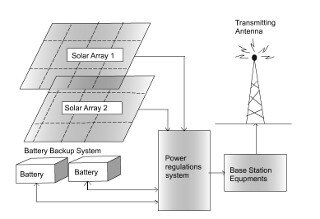For the past ten years, there has been much research into low-power radios for wireless sensor networks. Recently there has been a surge in interest in saving power in mobile data networks. The recent interest in low-power mobile data is connected to the current explosion in the amount of wireless data.
A large portion of providers’ operational cost is power for base stations (BSs). Power accounts for 18% of costs in Europe and 32% in India. The telecommunications industry accounts for 2% of all CO2 emissions. That is expected to double by 2020.
Researchers are developing buffer models to work out how large a battery a BS with a certain usage profile needs when powered by an a particular harvested energy source (e.g. solar, wind). This may work in places where it’s inconvenient to run power. These locations present a networking problem too because it’s also inconvenient to run a wired backhaul. If wired power is available, it will be more efficient to use it. The environmental saving can be replicated by funding renewable power generation in windy or sunny areas.
Another power-saving option is to switch off BSs when traffic is low. This could yield a 25% - 30% energy saving. Fewer BS means increased average distance between mobile and base. This may require the mobiles to transmit at higher power outputs, reducing battery life.
Mobile battery life is another diver for low-power wireless. A Chinese consumer research study found 60% of users report battery life limits their use of 3G services. This is not surprising because computing power doubles every two years, while battery energy density has been taking ten years to double.
Optimizing transmission modes for power efficiency may help. For example, M-ary frequency-shift keying (MFSK) is thought to be more efficient than M-ary quardrature amplitude modulation (MQAM). Recent research finds that this only true for high-power transmitters. For short-range low-power links, MQAM is more efficient. Similarly, channel conditions determine whether MIMO increases or decreases energy efficiency. 
Saving power in mobile data networks relates tangentially to Bluetooth Low Energy (BLE). BLE is a low-overhead protocol geared toward consumer devices that are similar to networked sensors. From my personal experience, there is a firestorm of interest in implementing BLE in consumer products.
I am unclear whether efforts to reduce mobile data energy use should be called “green”. There is overwhelming evidence that CO2 is a problem in the environment, but reducing wireless energy use won’t put a dent in CO2 emissions. On the other hand, if all industries take similar efforts, maybe it will add up to significant reductions. The direct cost of energy, not counting the long-term costs to the environment, will be sufficient impetus for energy saving measures.
Further Reading
- Green Wireless Communications Networks: An easy-to-read editorial in the most recent edition of IEEE Network.
- A Survey of Energy-Efficient Wireless Communications: A broad technical overview of energy-saving possibilities.
- On Greening Cellular Networks Via Multicell Cooperation (This article is available for free here for a limited time.)
